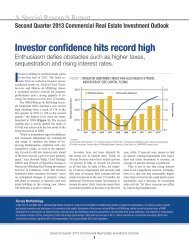The Nation's 50 Largest Apartment Owners And 50 Largest
The Nation's 50 Largest Apartment Owners And 50 Largest
The Nation's 50 Largest Apartment Owners And 50 Largest
Create successful ePaper yourself
Turn your PDF publications into a flip-book with our unique Google optimized e-Paper software.
A special Supplement to national real estate investormarkets,” recalls Jeff Franzen, executive vice presidentof Lincoln Property Company, which tried unsuccessfullyto go public in the early 1990s.Today, in 2009, apartment REITs occupy someof the top slots on the NMHC <strong>50</strong>, drawing on thepublic markets to borrow cheaply and leveragingtheir scale to operate more efficiently as they deliverdividends to shareholders.Since their emergence, they have reshaped theindustry in several ways. “If I think back 25 yearsago, multifamily properties were not consideredinvestment-grade,” Manning says, recalling a businesssituation that seems unthinkable today, wherepension funds and private equity alike investin apartment properties and portfolios. “REITsbrought a whole new institutional discipline tothe marketplace, encouraging capital sources tolend, own and invest in multifamily.”That interest in multifamily investmentextended far beyond the apartment REITs as privatefirms adopted many of the REITs’ best practices in technology,branding, and more. “<strong>The</strong>y’ve been helpful [to theindustry] in many ways,” Brodsky says. “<strong>The</strong>y have acceleratedthe professionalism of management,” including betterfinancial reporting and greater staff development. “You cansee over time that investors have become more comfortable,”he adds. “<strong>The</strong>ir confidence to make investments helpsus even though we are not a REIT.”<strong>The</strong> Paramount, San Francisco, CA(<strong>The</strong> Related Companies)Warren Rose - Edward Rose & SonsRelated certainly considered it.“We, as everyone did in the mid-1990s when REITsproliferated, analyzed the REIT form” and whether itwould work for Related, remembers Brodsky. “Steve Ross[Related’s chairman] says ‘it’s the best decision that wenever made.’”Related, which owns, manages, and develops a diversereal estate portfolio that includes apartments, condos,retail, and trade show space, ultimately decided the REITstructure—and the analyst expectations that accompaniedit—would be too limiting. “<strong>The</strong> REIT form does not fit theculture of our company or our product segments,” Brodskyexplains.Others have also remained private, choosing instead towatch what apartment REITs do, including their choicesto cluster in coastal markets, and to do the opposite. “Ourstrategy is to stay away from markets they are in,” says Rose.“We can survive in secondary and tertiary metropolitanareas” such as Peoria, IL, or South Bend, IN.Even firms that missed the REIT moment by choice orby chance say they have reaped the benefits of the modeleven without adopting it. As REIT stocks raised capital bycapturing everyday investors, “all the traditional sources ofcapital were flowing as usual, so we ended up with betteraccess to capital,” says Lincoln’s Franzen.<strong>The</strong> multifamily industry did not realize all its REITrelateddreams, however. While the reputation and professionalismof the apartment business has improved significantly,“I don’t think the information [about geographicand other multifamily markets] is dramatically better,”Franzen asserts.18 NMHC <strong>50</strong> APRIL 2009










